Acropolis
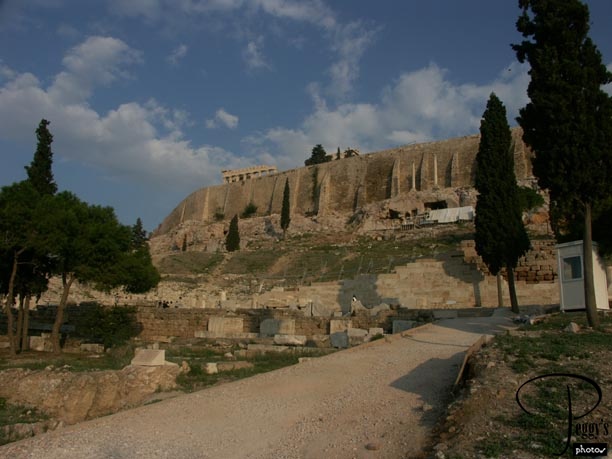
I started out early this morning to beat the crowds of tourists at the Acropolis. This time I found Dionissious Aeropagitou, part of the Unification of Archeological Sites Walk, very easily and it took me only about 5 minutes to reach one of the entrances to the Acropolis. No cars are allowed on the Unification Walk, but cycles are and you have to watch out for them. The ticket to enter was about 12 euros and it also gives you entrance to a number of other archeological sites. The word “acropolis” means the ancient fortified part of an ancient Greek city. The Athens Acropolis contains a number of buildings other than just the Parthenon, the most famous of all of them. The photo shows the Acropolis wall and part of the Parthenon.

Acropolis
Statues

There is another entrance into the Acropolis higher up on the hill, but if you don’t enter from where I did or else go down the hill this way, you will miss some of the sights near the bottom of the hill. These sights are still part of the Acropolis. First, off to the side of the entrance, were parts of ancient statues.

Statues
Statue
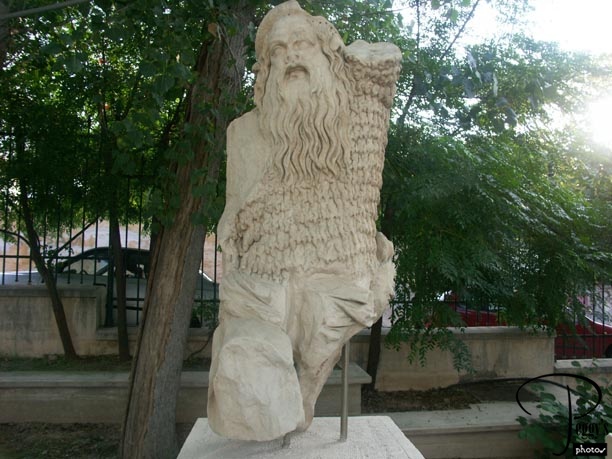
This was part of a statue of Papposilenos that was part of the Theatre of Dionysos dating back to the 1st or 2nd century AD. This was a Roman statue. See next photos.

Statue
Theatre of Dionysos–Greek
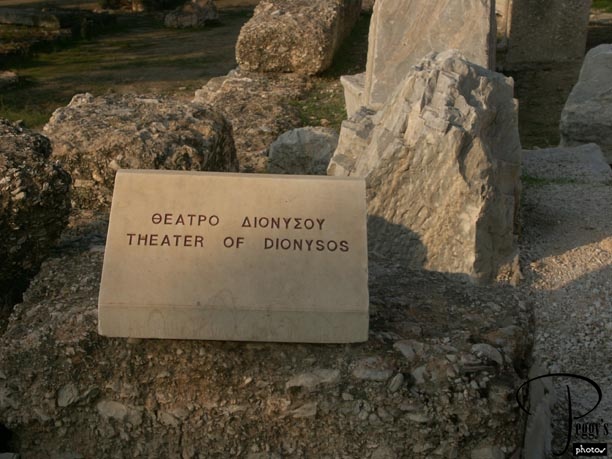
These stones are part of what is left of the original Theatre of Dionysos (named after the god of wine and revelry), built between 342 and 326 BC by the ancient Greeks. This was the birthplace of Greek tragedy. Aeschylus, Sophocles, Euripides, and Aristophanes all had their plays performed here.

Theatre of Dionysos–Greek
Theatre of Dionysos–Roman
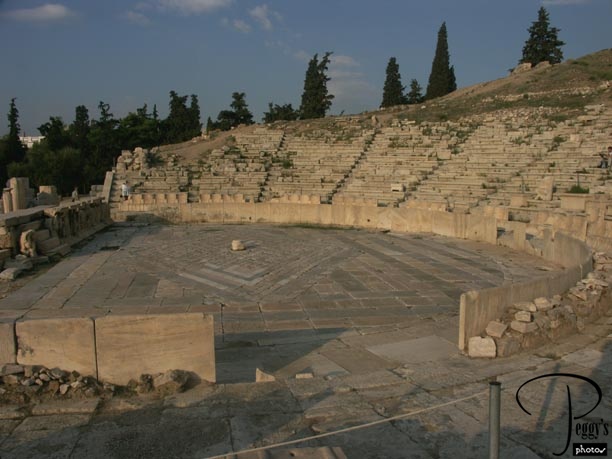
The Romans captured Athens in 86 BC. This is why you see both Greek and Roman ruins in Athens. This photo is of the Roman Theatre of Dionysos. It could seat 17,000 people.

Theatre of Dionysos–Roman
Theatre of Dionysos–Roman
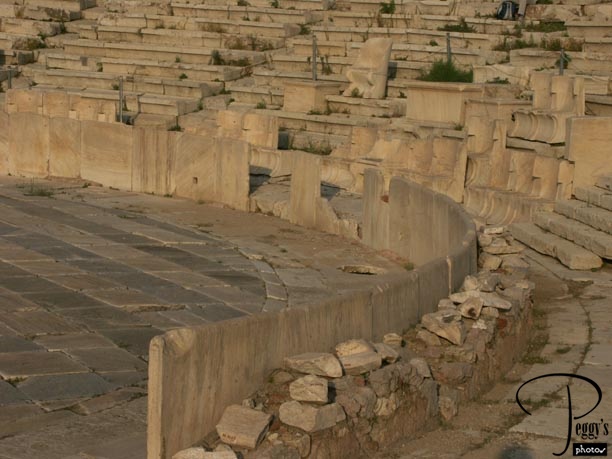
The best seats were reserved for the priests of Dionysos, with the head priest’s throne located in the center. See the seats in the front row and on top of one of the rows in the photo. I assume that these are the seats of the priests.

Theatre of Dionysos–Roman
The Acropolis Wall
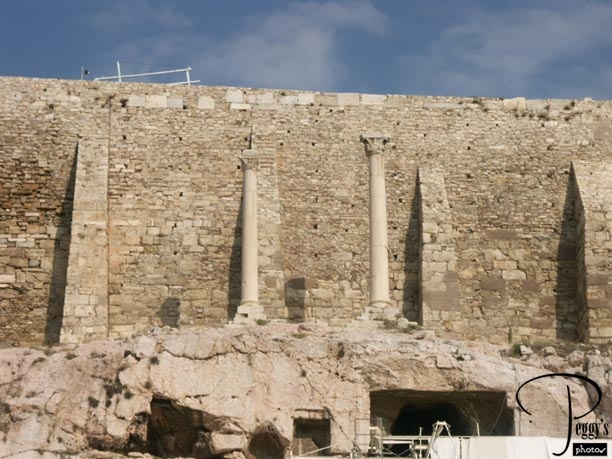
These two Corinthian columns are the only ones remaining of the columns erected by the sponsors of the plays. You can also see the renovation of the Panagia Spiliotissa, which is a chapel set in a cave in the Acropolis rock.

The Acropolis Wall
Chapel
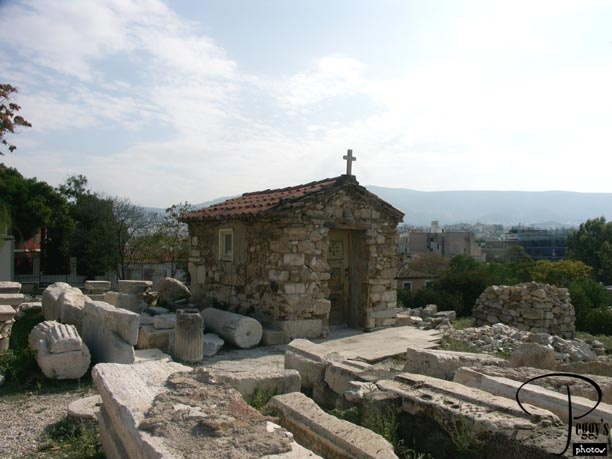
Not an ancient ruin, but an old Greek Orthodox chapel on the grounds of the Acropolis. You see many chapels in Greece where you would least expect them. You can also see in the photo parts of ancient columns.

Chapel
Theatre of Herodes Atticus
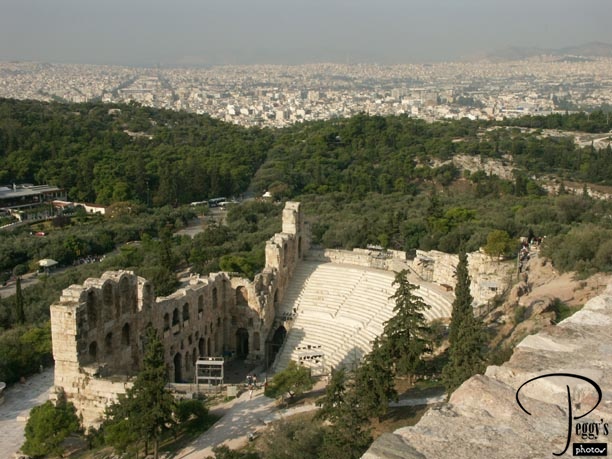
Also called the Odeion of Herodes Atticus. It is a Roman theatre built by Herodes Atticus, a wealthy Athenian. It was started in 161 AD and was restored in 1955. Today, performances are held in it from about mid–May to early October, with stars such as Placido Domingo performing. This is the view of the theatre from near the top of the hill.

Theatre of Herodes Atticus
Theatre of Herodes Atticus

The front of the theatre. Photo taken on a different walk.

Theatre of Herodes Atticus
Stoa of Eumenes
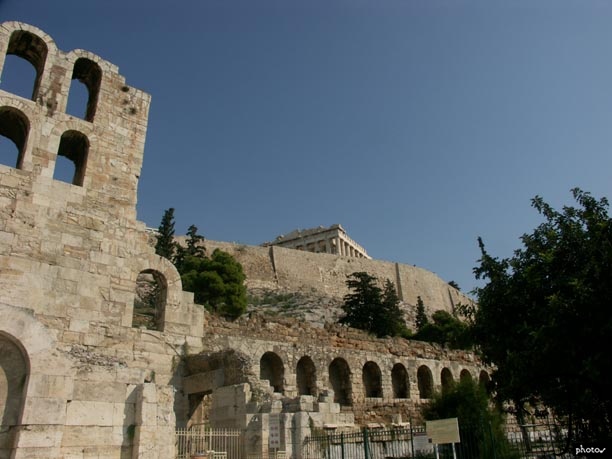
This ancient stoa (covered walkway) is next to the theatre.

Stoa of Eumenes
Entrance to top of the Acropolis
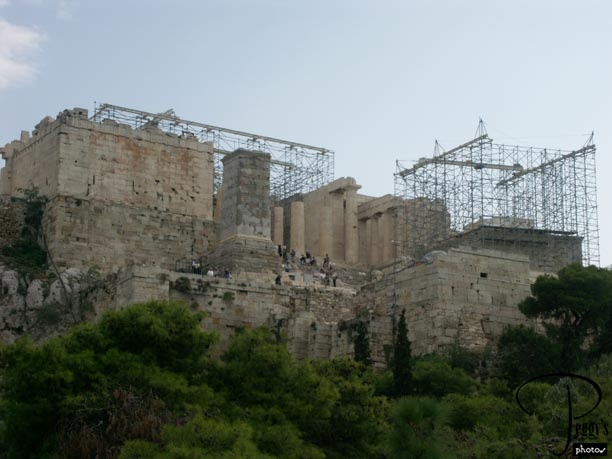
I took this photo later from the top of Areopago Hill, but include it here to better show this entrance. The Beule Gate, the original entrance to the Acropolis, is below the present entrance––the Propylaia. You can see the steps into the Propylaia. The Temple of Athena Nike is on the right of the Propylaia. The Monument of Agrippa is on the left, in front of the Propylaia.

Entrance to top of the Acropolis
The Beule Gate
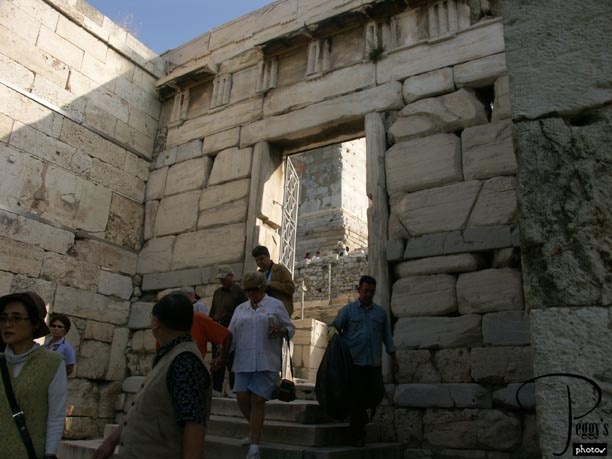
The original entrance to the Acropolis was through the Buele Gate, shown in this photo.

The Beule Gate
The Beule Gate
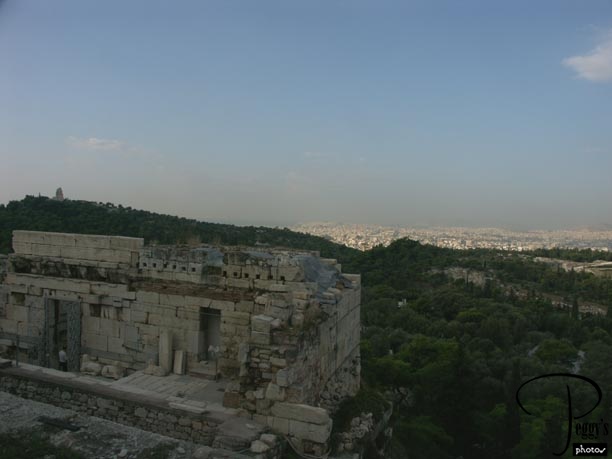
The Beule Gate from above.

The Beule Gate
The New Entrance to the Acropolis
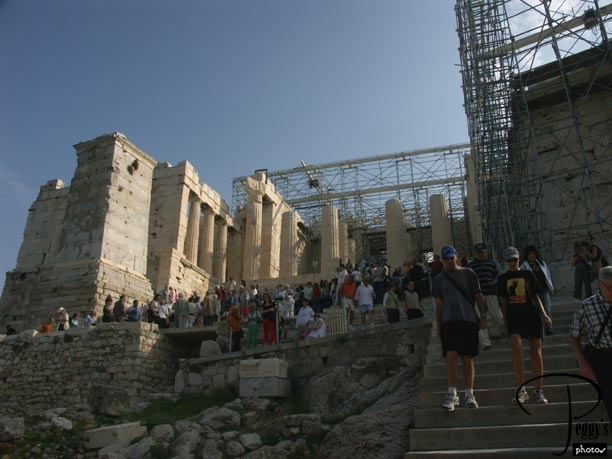
The first settlement on the Acropolis was during the Neolitic period––around 3000 BC. In the mid 5th century BC, Perikles began a program to erect new buildings on the Acropolis. He commissioned the building of three temples and a huge new gateway, called the Propylaia, which was built in 437–432 BC. The Propylaia is in the middle of the photo, the Temple of Athena Nike (the goddess of victory) is on the right, and what is left of the Monument of Agrippa is the rectangular standing column on the left. The Temple of Athena Nike was built in 426–421 BC to commerate the Athenians’ victories over the Persians. No matter which entrance you take to reach the top of the Acropolis, you will end up here. The route that I took hugged the steep cliff, had some steps, and also some places where you wouldn’t want to lose your footing as you would have fallen over the cliff if you did. I had also to be careful going up the steps of the Propylaia. How nonuser friendly the Acropolis ruins were suprised me. You need to be a sure–footed, in–shape person to feel comfortable doing your Acropolis sightseeing. I just felt very glad that I didn’t wait any longer––agewise––to visit Greece.

The New Entrance to the Acropolis
Monument of Agrippa
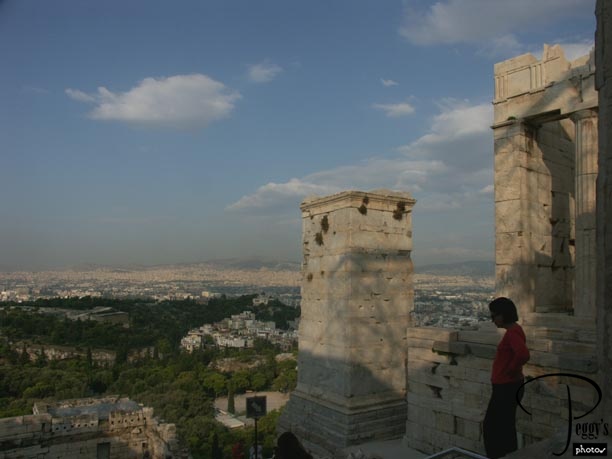
Another view of the remains of the Monument of Agrippa.

Monument of Agrippa
The Parthenon
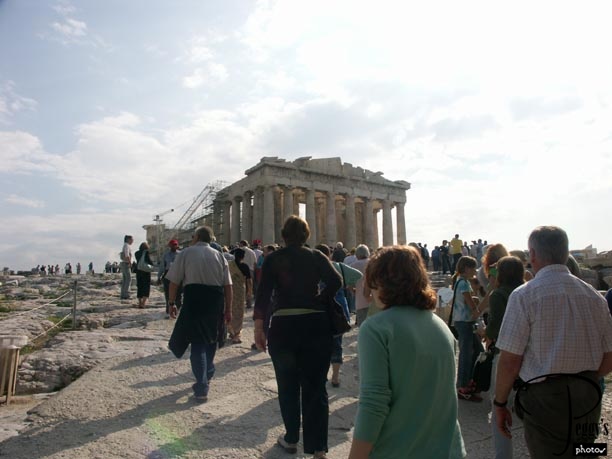
Through the Propylaia walking to the Parthenon.

The Parthenon
The Parthenon
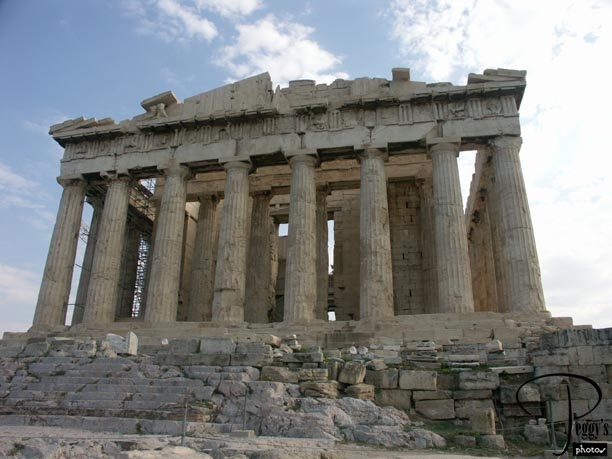
The front of the Parthenon, the most famous building in Greece. Building of the Parthenon began in 447 BC. This temple was built to house a 40–foot–high statue of Athena, the patron goddess of Athens. The Panthenon is considered to be an architectural masterpiece, as it was built using a 9/4 ratio so that it looks completely symmetical from every view.

The Parthenon
The Parthenon
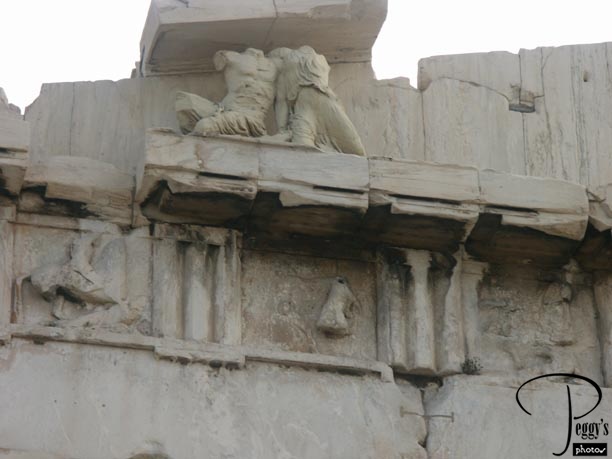
Close–up of the statues on top of the front of the temple.

The Parthenon
The Parthenon
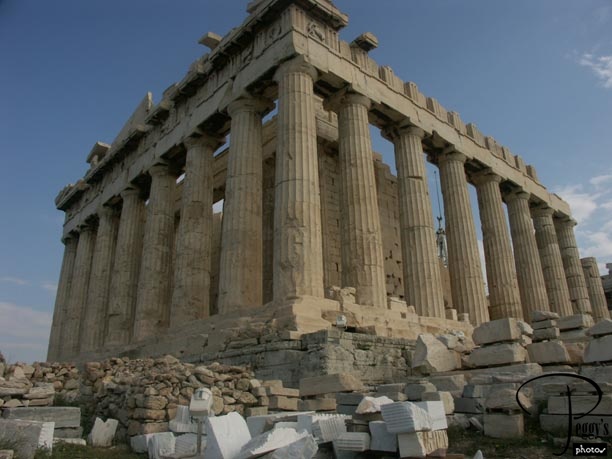
Moving to the right on its south side.

The Parthenon
The Parthenon
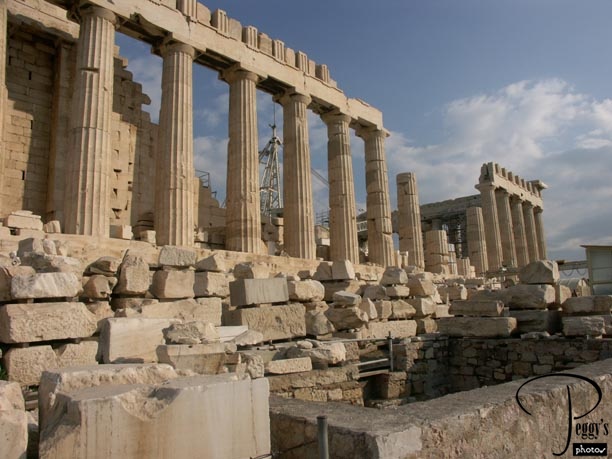
The south side.

The Parthenon
The Parthenon
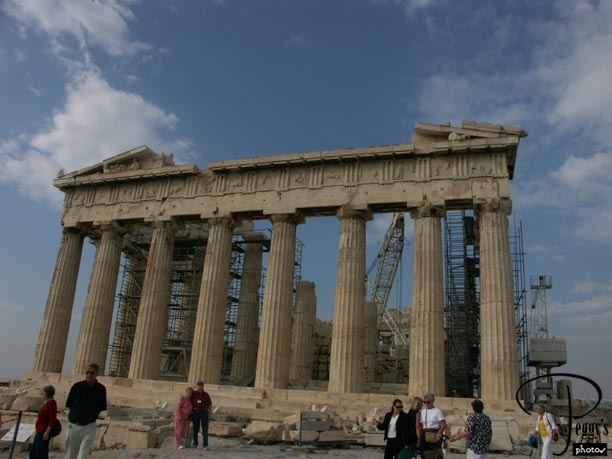
Turning the corner to the east side of the Parthenon.

The Parthenon
The Parthenon
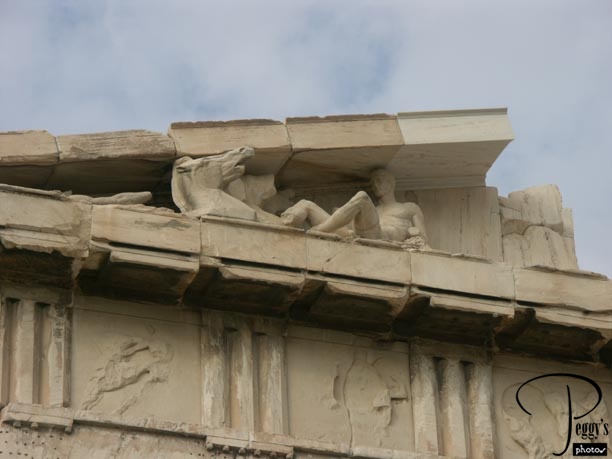
Close–up of the top of the left east side.

The Parthenon
The Parthenon

Close–up of the top of the right east side.

The Parthenon
The Parthenon
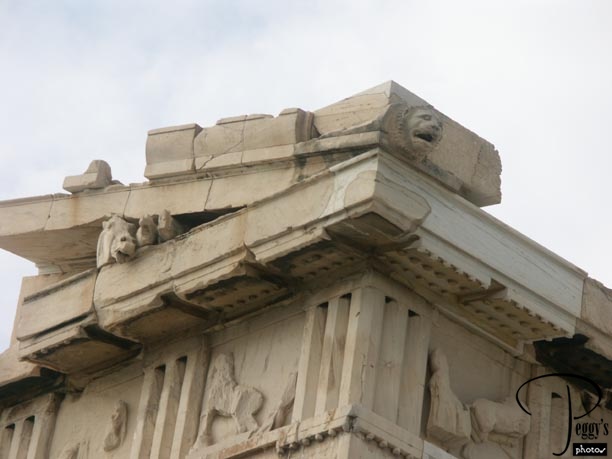
Turning the corner to the north side of the Parthenon.

The Parthenon
The Parthenon
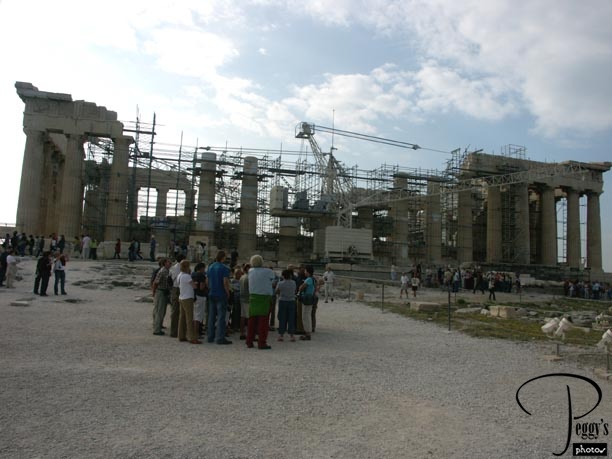
The north side of the Parthenon. Here’s a view that won’t appear in the travel guides.

The Parthenon
The Acropolis
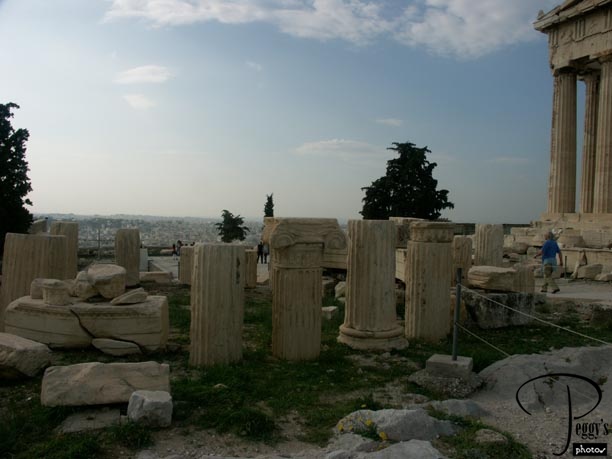
Some of the many parts of columns and marble pieces piled up on the ground.

The Acropolis
The Erechtheion
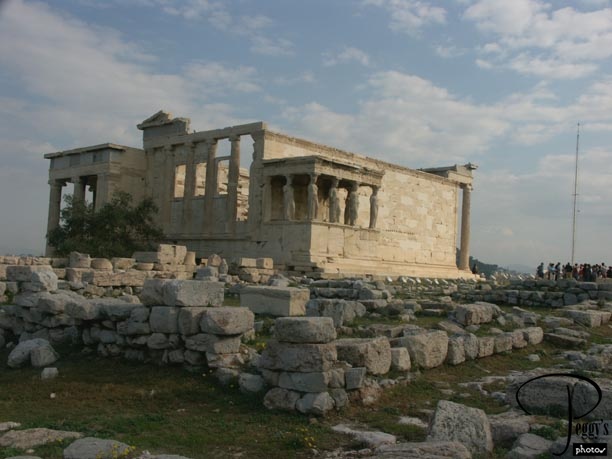
This is the third temple built on top of the Acropolis and it was erected (between 421 and 406 BC) on its most sacred site: Here marked the battle between the god Poseidon, the god of the sea, and the goddess Athena, the goddess of wisdom, for the control of Athens. Poseidon struck a rock here with his trident and out gushed a spring. But Athena gave the gift of an olive tree to be fed by the spring and she won.

The Erechtheion
The Erechtheion
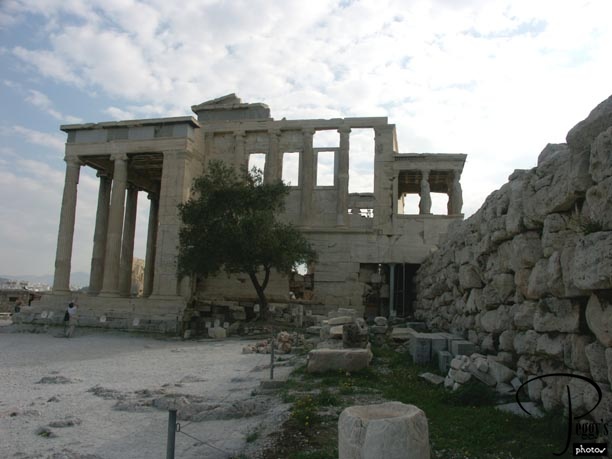
View of a side of the Erechtheion and the sacred olive tree (replanted since ancient times).

The Erechtheion
The Erechtheion
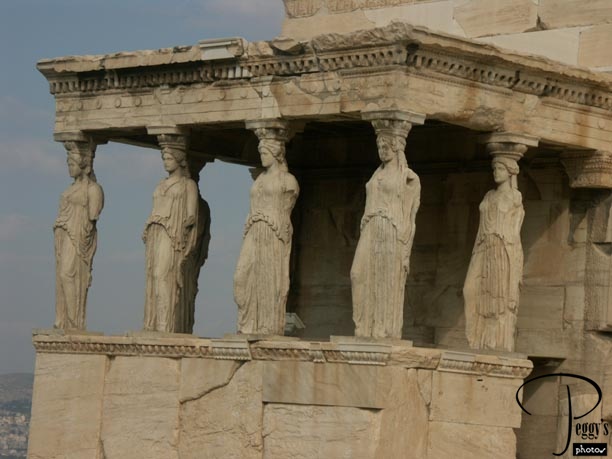
Close–up of the caratid statues on the Porch of the Caryatids. Caryatids are draped female figures that support a horizontal structure. These are casts of the original statues. Four of the original caryatids are in the Acropolis Museum.

The Erechtheion
The Erechtheion
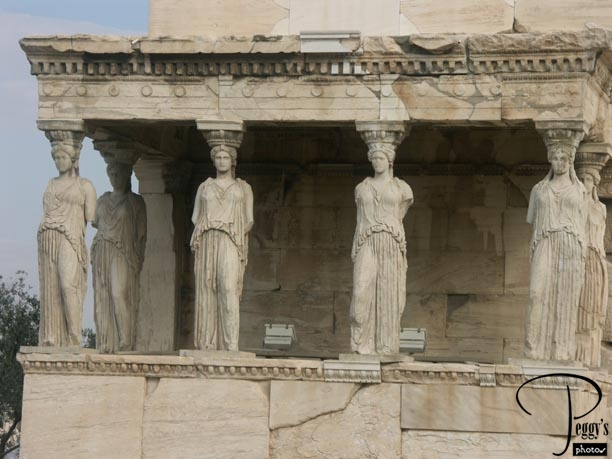
Photo of the caryatids taken from a different angle.

The Erechtheion
The Erechtheion
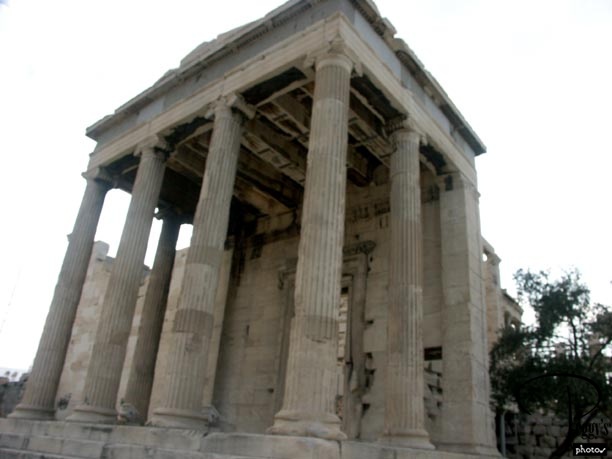
Another view of the Erechtheion.

The Erechtheion
The Erechtheion

Another view of the Erechtheion. I next visited the Acropolis Museum which is located here on top of the Acropolis. No photo taking was allowed inside it, but I can tell you that the original caryatid statues were beautiful. However, most of the Greek statues from the Parthenon are now in the British Museum in London. Around 1801–3, Lord Elgin acquired the Parthenon statues from the Turks who were occupying Greece. Once acquired, Lord Elgin sold them to the British government––an event that the Greeks are not very pleased about. There are also ruins of other buildings on the top of the Acropolis, but they appear now little more than large stones.

The Erechtheion
View from the Acropolis
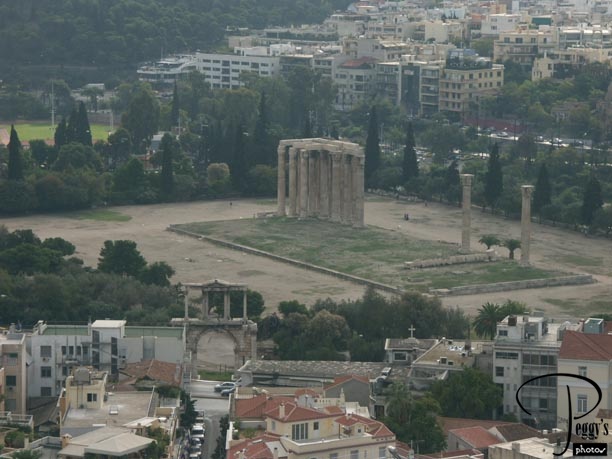
There are great views of various sights in Athens from the top of the Acropolis. This is of the Greek Temple of Olympian Zeus and the Roman Hadrian’s Arch. My hotel was across the street from the Temple of Olympian Zeus and I visited it on another day.

View from the Acropolis
View from the Acropolis
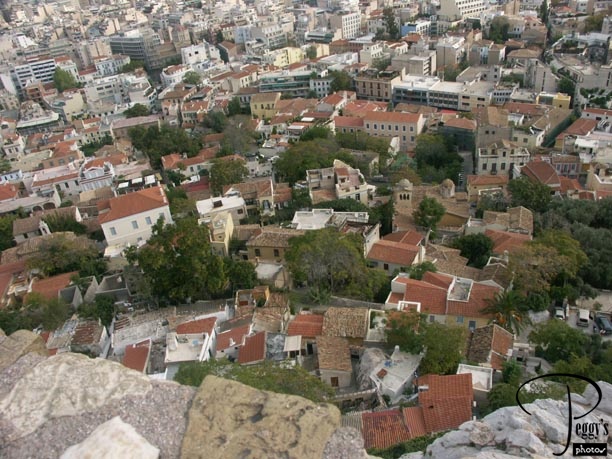
A view from above of the section of Athens that I visited yesterday––Anafiotkia. I do not see any houses with domed roofs in the photo.

View from the Acropolis
View from the Acropolis
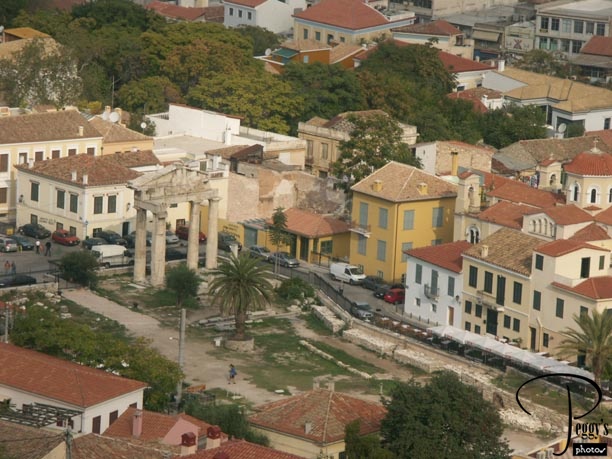
The Roman Agora, which I also visited on another day.

View from the Acropolis
View from the Acropolis
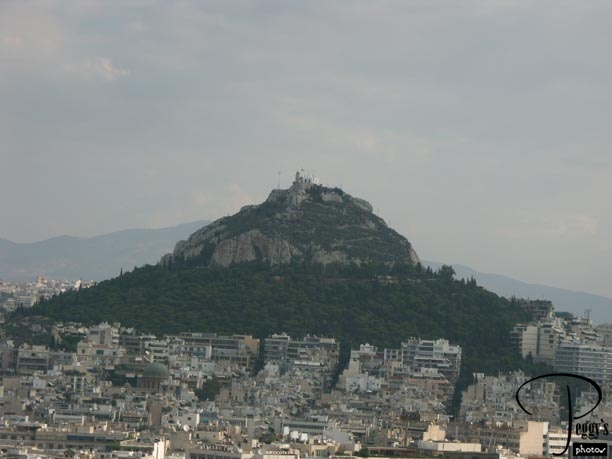
Lycabettus Hill, which I also visited on another day.

View from the Acropolis
View from the Acropolis
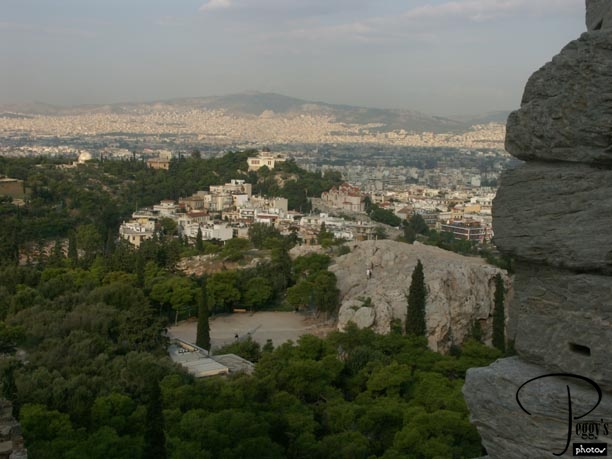
Areopago Hill, also called the Sacred Hill (middle of the photo). In 51 AD, on this hill, St. Paul delivered his “On an unknown God” sermon and gained his first convert to Christianity: Dionysos, the namesake of, but not, the god Dionysos. This Dionysos became the Bishop of Athens.

View from the Acropolis
Areopago Hill
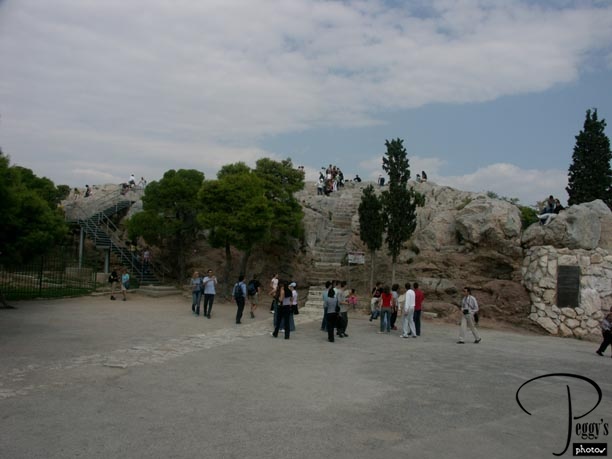
I left the Acropolis––there was a modern staircase down (down only) the Propylaia. I guess someone didn’t think that it would be a good idea for people to be walking both up and down those marble steps––and went down to Areopago Hill. There were a choice of two staircases up the hill––I, of course, picked the one on the left.

Areopago Hill
Areopago Hill
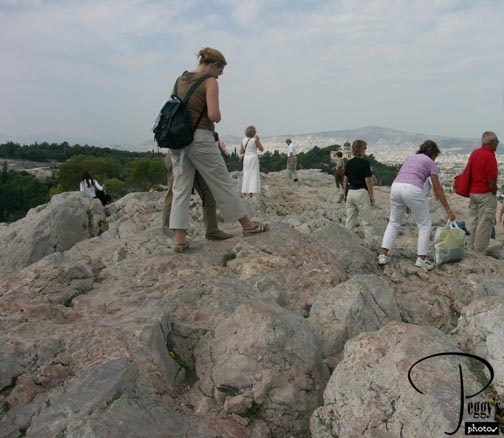
Making your way over the large rocks on top of the hill.

Areopago Hill
Areopago Hill
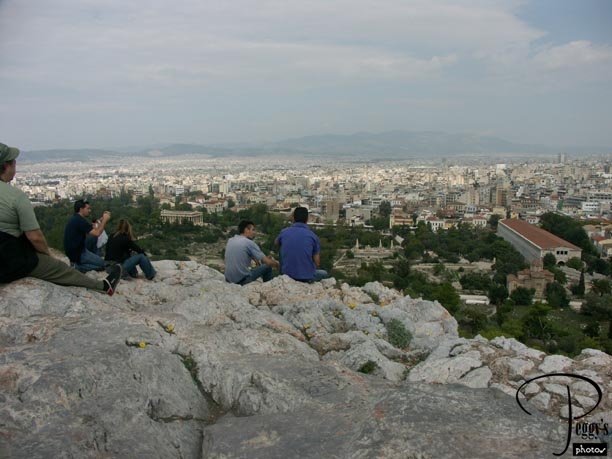
View from Areopago Hill. The Ancient Agora can be seen below.

Areopago Hill
Areopago Hill
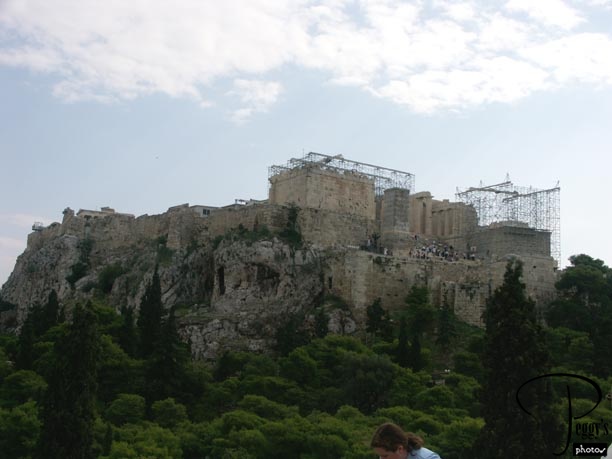
View of the Acropolis from the top of Areopago Hill. I very carefully climbed down the hill and next went to visit the Ancient Agora.

Areopago Hill
The Ancient Agora
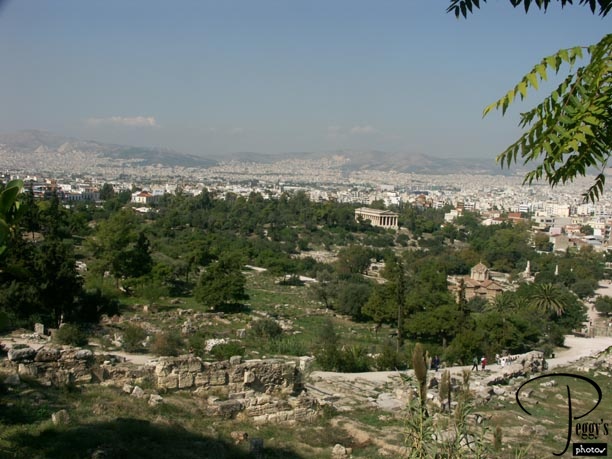
From the Acropolis, I walked down the Panathenaic Way (named after a festival which took place here every four years) to the Ancient Agora. This was the city center of Athens for 1,200 years from the 6th century BC. It was a marketplace and also the social, political, commercial, religious, and arts center of Athens, with theatres, schools, government buildings, and temples. Socrates “corrupted the youth of Athens” here and St. Paul preached here. The church on the middle right of the photo is from later times: the Church of the Holy Apostles. The “panthenon–like” building farther back in the photo is the Hephaisteion.

The Ancient Agora
The Ancient Agora
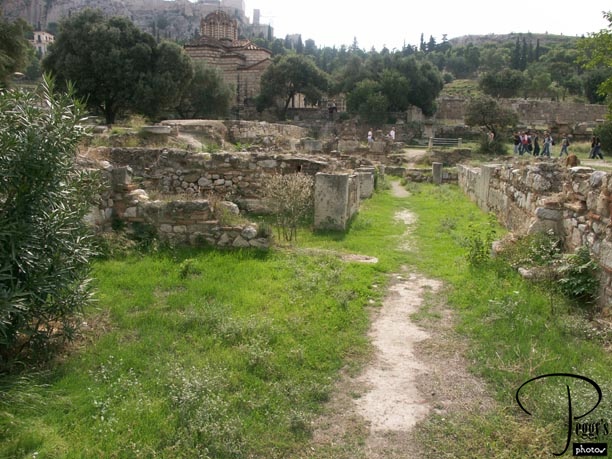
Ruins of the Ancient Agora and the Church of the Holy Apostles.

The Ancient Agora
Church of the Holy Apostles
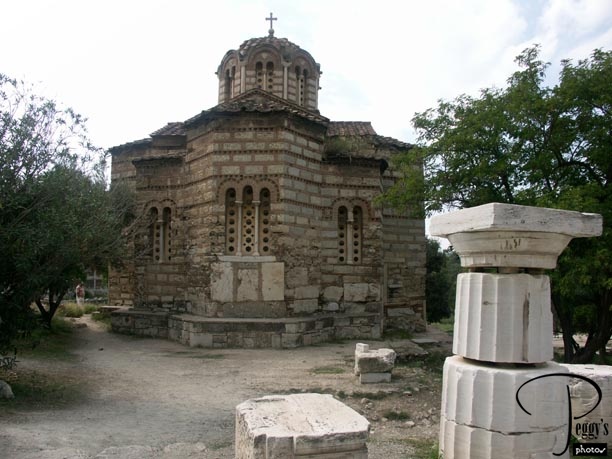
The Church of the Holy Apostles was built in the 11th century when Greece was part of the Byzantine Empire. It has been altered many times through the centuries but was restored to its original form in 1954–56.

Church of the Holy Apostles
Church of the Holy Apostles
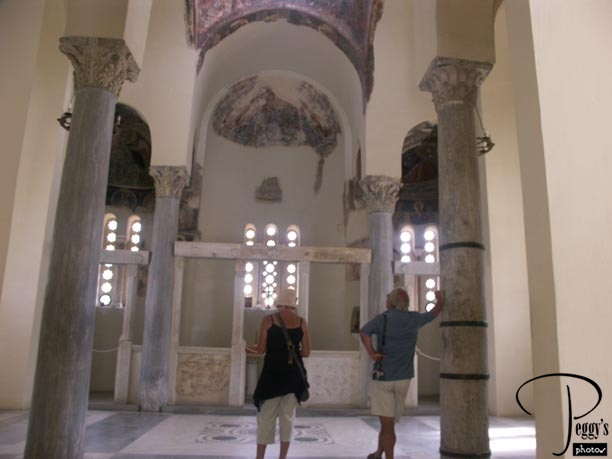
Inside the church.

Church of the Holy Apostles
Church of the Holy Apostles
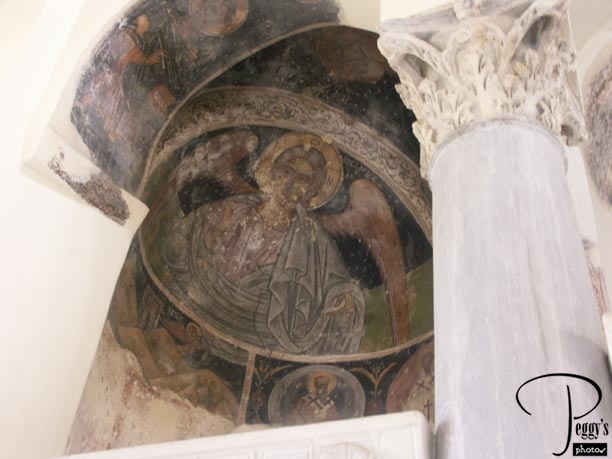
The frescoes in the photo were found under the plaster that had been put over them.

Church of the Holy Apostles
Church of the Holy Apostles

This fresco was probably originally from St. Spyridon, a neighboring church.

Church of the Holy Apostles
Church of the Holy Apostles
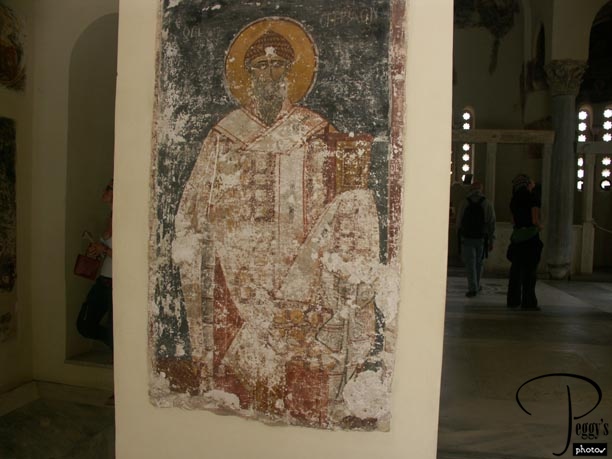
This fresco was also probably from St. Syridon.

Church of the Holy Apostles
Church of the Holy Apostles
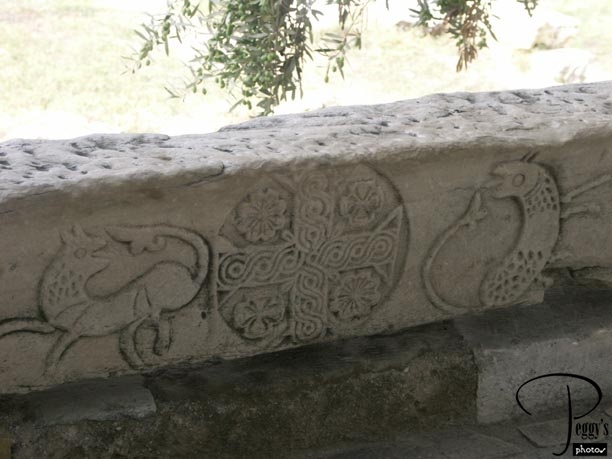
Pattern in a stone wall in front of the church.

Church of the Holy Apostles
Ancient Agora and Stoa of Attalos
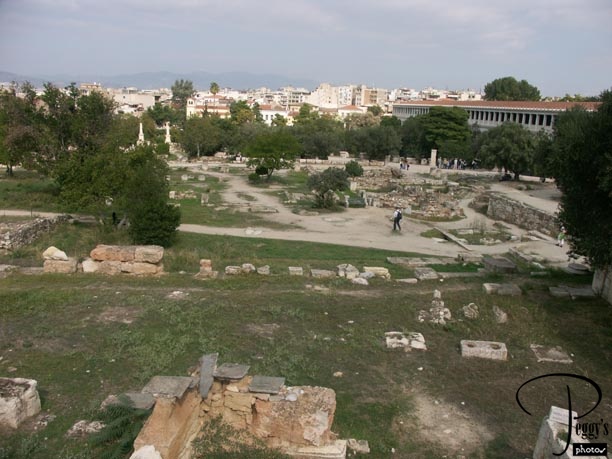
View of the ruins of the Ancient Agora and the reconstructed Stoa (marketplace) of Attalos on the right.

Ancient Agora and Stoa of Attalos
Stoa of Attalos
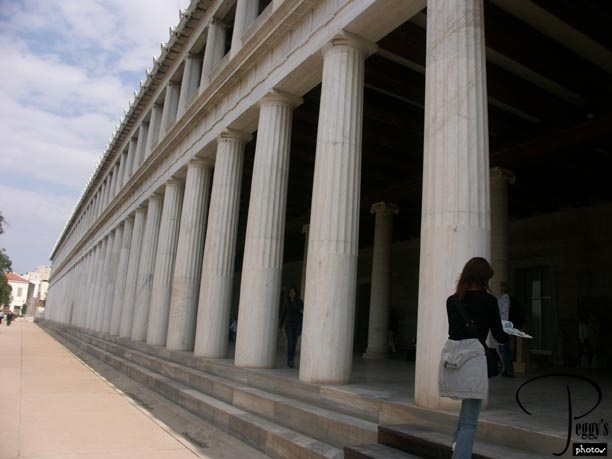
Close up of the Stoa of Attalos which was built in the 2nd century BC by King Attalos of Pergamon as a center for retail trade. It was completely renovated in 1950 using the original foundation and ancient materials. It now serves as the Agora Museum, containing many artifacts of life in the Agora such as vases, toys, portable ovens, and voting tablets. I found it to be an interesting museum. However, no photos were allowed in it.

Stoa of Attalos
Stoa of Attalos
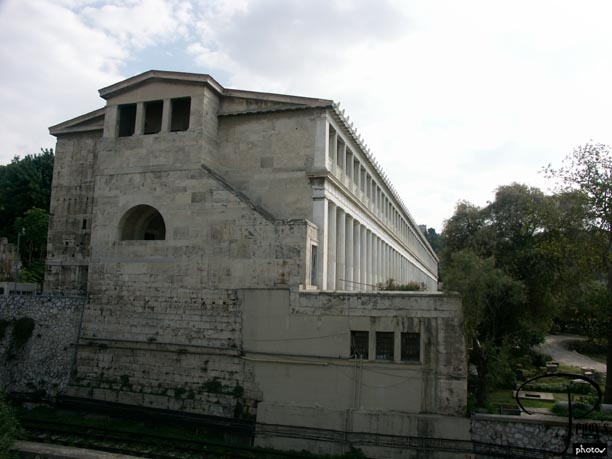
View of a side of the stoa.

Stoa of Attalos
Stoa of Attalos
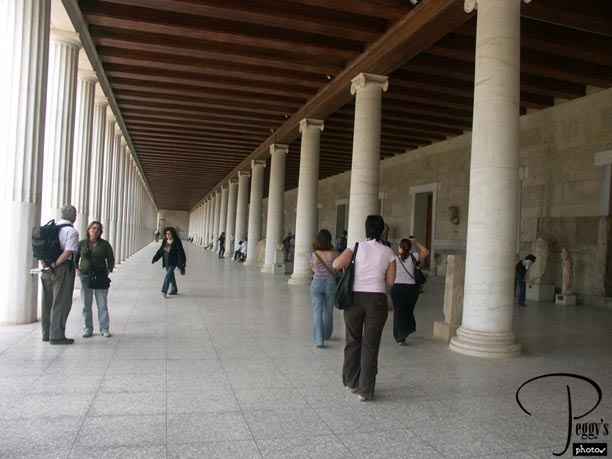
Between its columns.

Stoa of Attalos
Stoa of Attalos
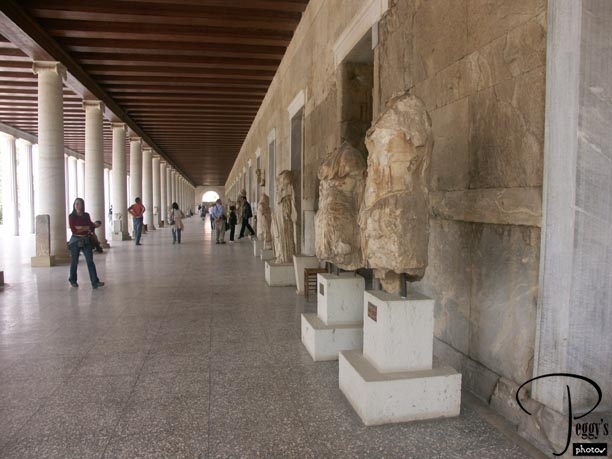
Ancient statues along its wall.

Stoa of Attalos
Stoa of Attalos
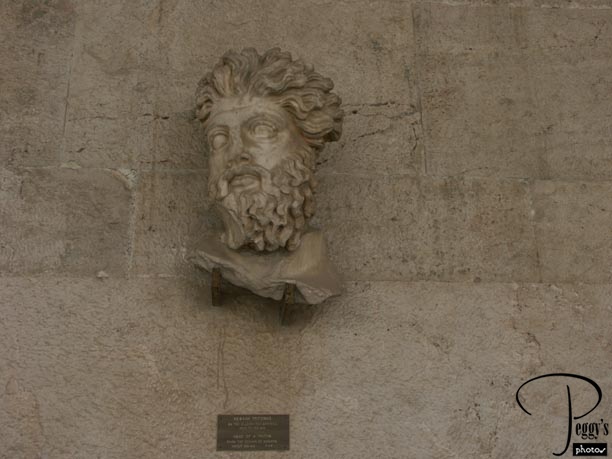
Head of a Triton (half–god, half–fish) from the Odeion (theatre) of Agrippa, which was a concert hall in the Agora. The statue head dates back to 150 AD.

Stoa of Attalos
Stoa of Attalos
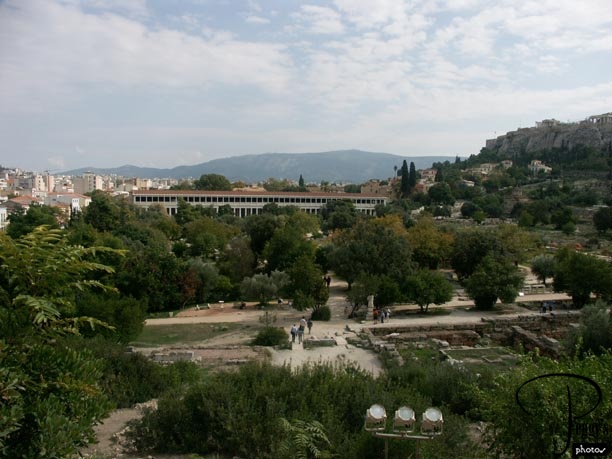
View of the stoa from the hill where the Hephaisteion is located on. The top of the Acropolis can be seen on the upper right part of the photo.

Stoa of Attalos
Ancient Agora and the Hephaisteion
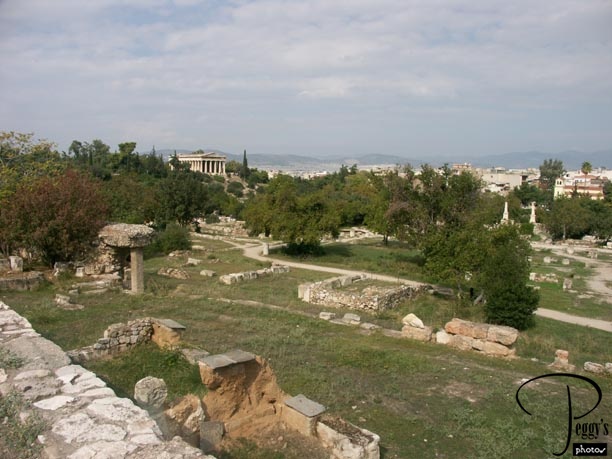
View of the ruins of the Ancient Agora with the Hephaisteion on the hill in the left middle rear of the photo.

Ancient Agora and the Hephaisteion
The Hephaisteion
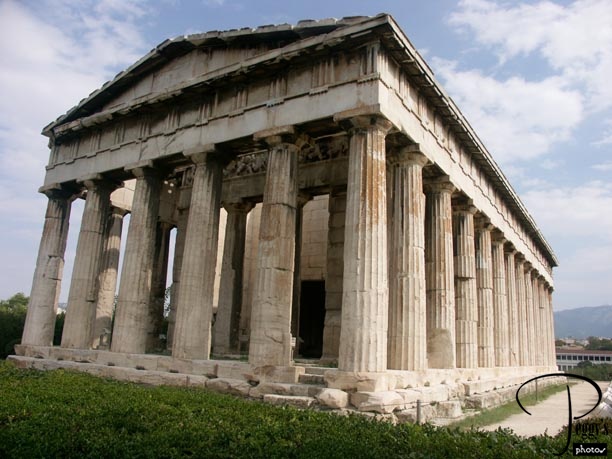
The Hephaisteion, also called the Theseion, was built in 449–440 BC as a shrine to Hephaetus, the god of fire and metalworking (in Roman mythology, this god is named Vulcan). The Hephaisteion is the best–preserved classical–era temple in all of Greece.

The Hephaisteion
The Hephaisteion
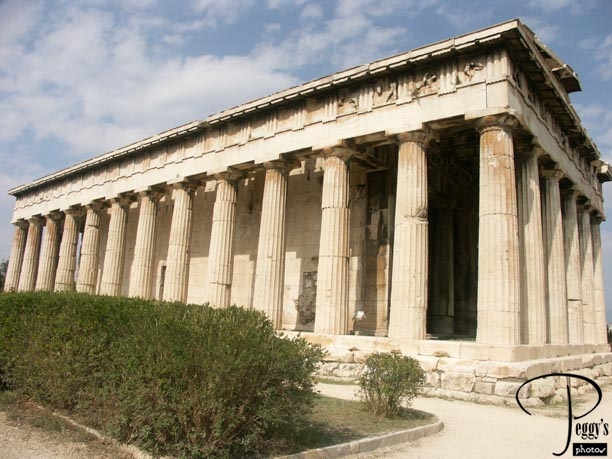
The side of this temple.

The Hephaisteion
The Hephaisteion
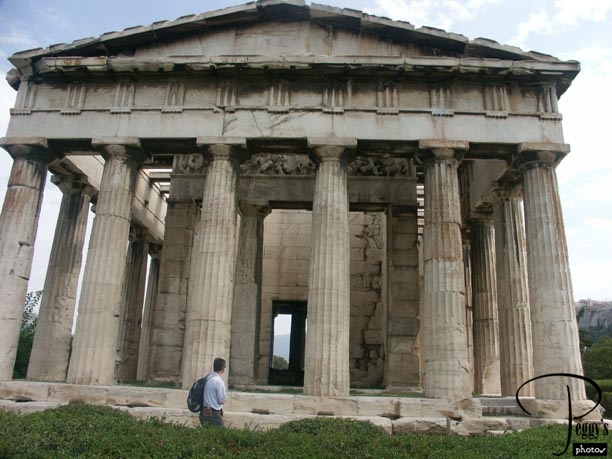
View of the front of the temple.

The Hephaisteion
The Hephaisteion
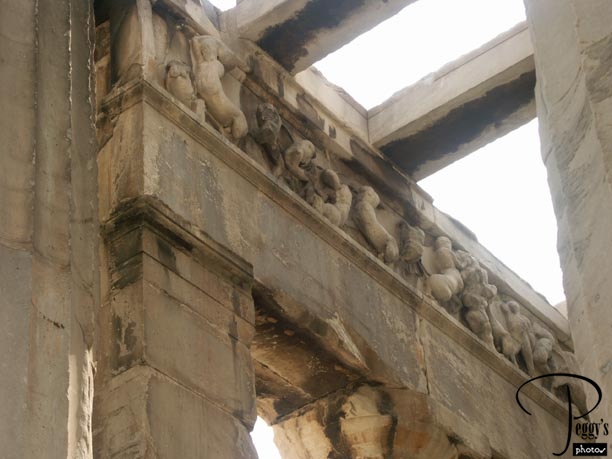
Frieze inside the temple.

The Hephaisteion
Tritons
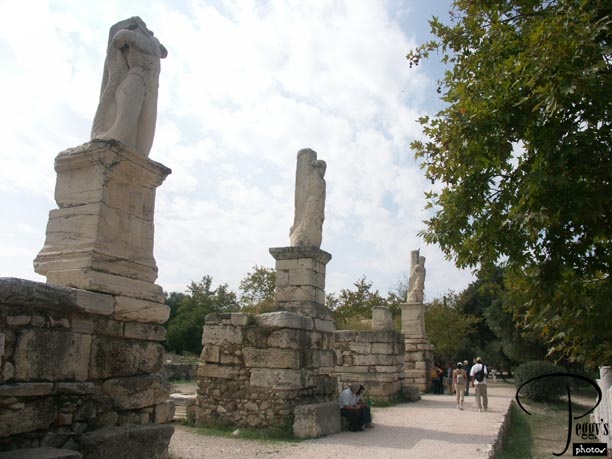
These Triton statues adorned the Odeion of Agrippa.

Tritons
Statue of Hadrian
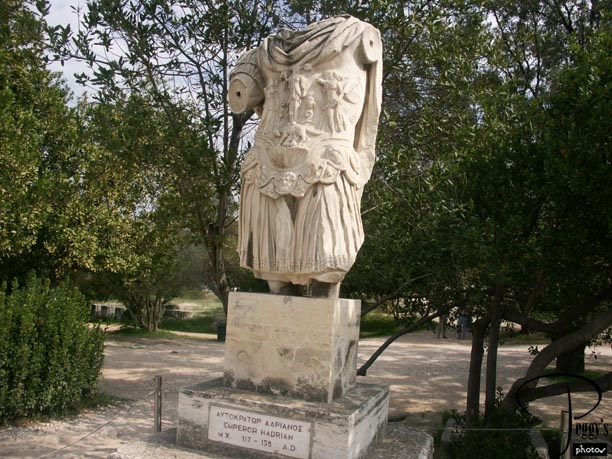
This statue of Hadrian, the Emperor of Rome from 117–38 and also ruler of Athens, is from the 2nd century AD and sits in the Ancient Agora.

Statue of Hadrian
Corinthian Column
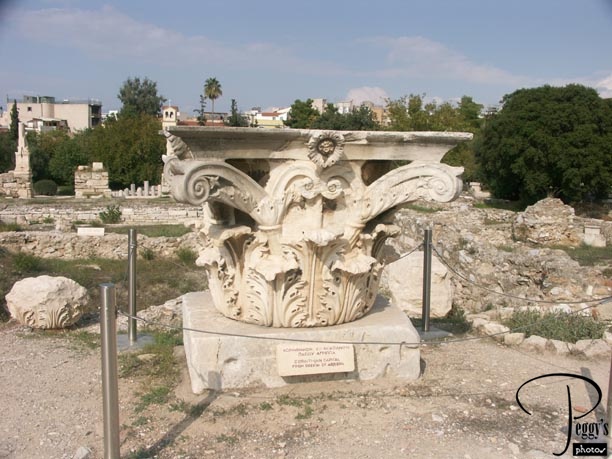
This column on the grounds of the Ancient Agora was part of the Odeion of Agrippa.

Corinthian Column
Altar of Zeus Agoraios
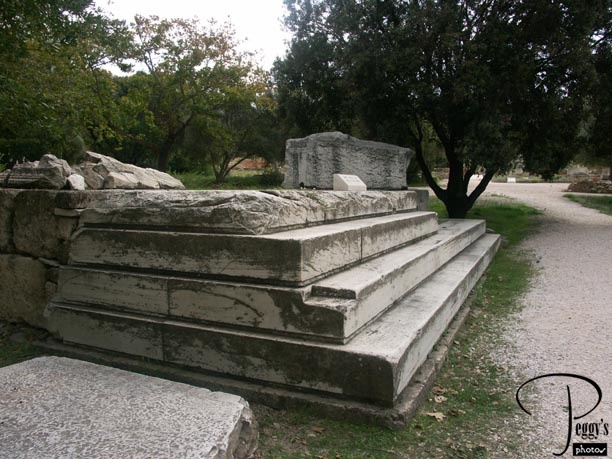
Without the signs placed on or near the ruins, it would be hard to tell what most of the ruins are of. A sign told me that this was the Altar of Zeus Agoraios.

Altar of Zeus Agoraios
Civic Offices
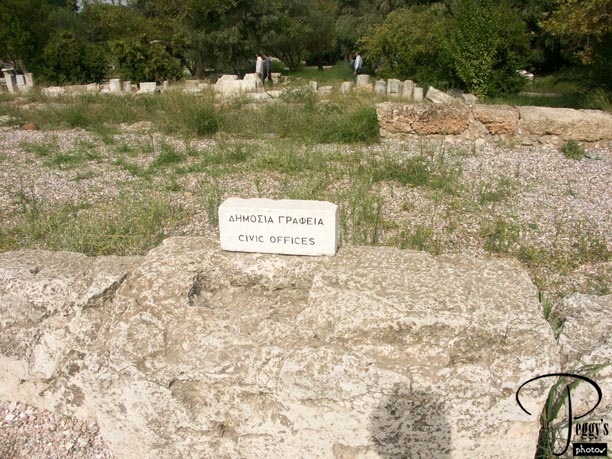
Ruins of the civic offices.

Civic Offices
Sanctuary of Hekate
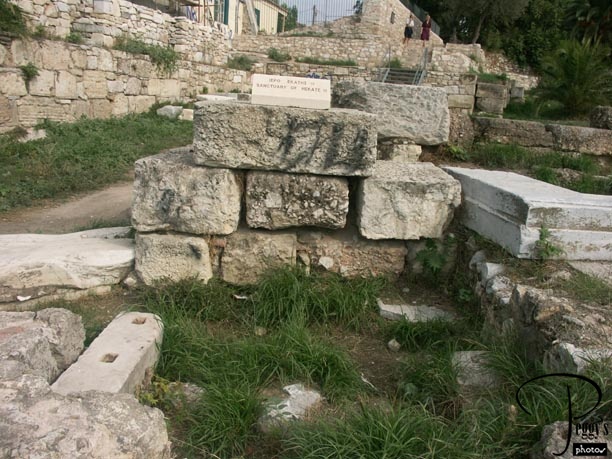
And these ruins are of the Sanctury of Hekate.

Sanctuary of Hekate
Across from the Ancient Agora
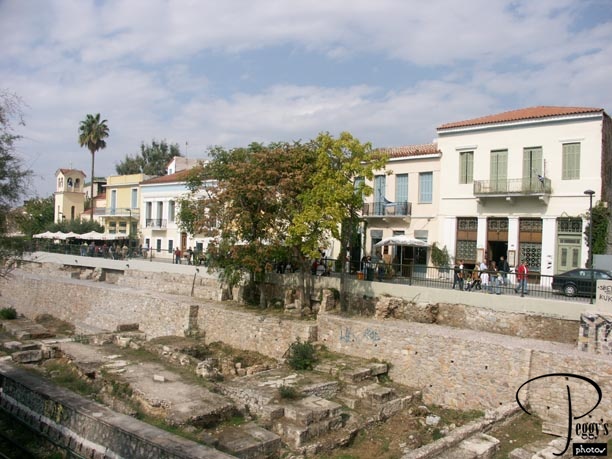
Across from the Ancient Agora, are, after a long day of walking up and down hills and many steps, inviting restaurants on the edge of a section of Athens called Monastiraki. (For those of you who have been to Athens or who are planning on visiting it, these restaurants are at the very end of the passageway through the Monastiraki Flea Market.) I wasn’t very hungry, so I ordered only a Greek salad, Diet Coke (called Coke Light in Europe), and coffee with cream, which came with a huge amount of whipped cream on top of it. Actually, it was quite good. Cost: 12.50 euros plus tip.

Across from the Ancient Agora
Back to My Hotel

It was about 3 p.m. and I was tired so I decided to head back to my hotel. I didn’t want to get lost again as I did yesterday, so I decided to walk back the same way that I had come, which turned out to be a very big mistake. There were very few people in the Ancient Agora at that time, as the tourists had finished their sightseeing earlier. For want of a better photo, I am putting this one on again. About in the middle of the pathway in the photo, there was a stray Athens dog asleep that I was hesitant to pass. I heard a motorcycle behind me on the hill, so I waited on the path for him to pass me and, hence, scare the dog away. However, he stopped besides me and started to talk to me in what I guess was Greek. He started becoming somewhat frustrated that I couldn’t understand him and then he turned his cycle around, grabbed my Trafalgar carry bag that I had on my shoulder, and sped back down the hill with it. I yelled, “Help, help,” which was heard by some young people down the hill. They waited until the thief came past them and then, so very bravely, pushed him off his cycle and he and his cycle went flying. They retrieved my carry bag.

Back to My Hotel
My Rescuers
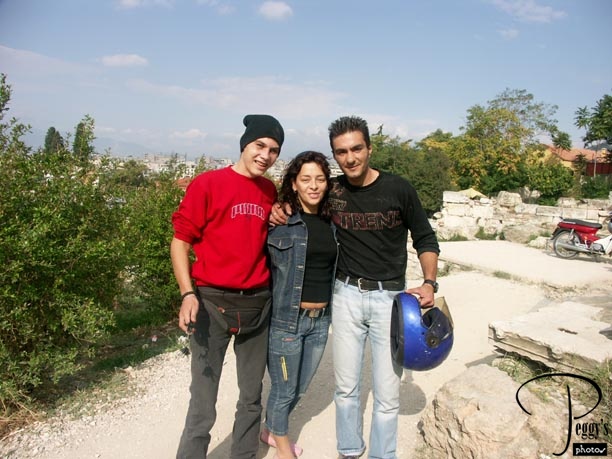
Here is a photo of the wonderful people who came to my aid. I offered a reward but they wouldn’t take it, but they did let me take their photo. Of course, this experience did make me nervous everytime a cyclist came nearby, and since there are hundreds of cycles in Athens, I was jumpy for several days. The Trafalgar reps told me that pickpockets are not unheard of in Athens but carry bag thiefs are and that I should not let the experience spoil my trip, but I did try to walk, from then on, only where there were enough other tourists.
